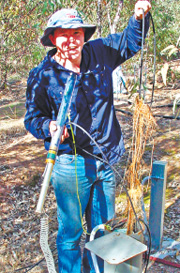
Where on farms to grow trees

More work will be done to confirm the best locations to plant trees in the agricultural landscape to reduce dryland salinity.
A new project will collect data from a number of sites to measure the impacts of various land use options, including tree planting, on sub-catchments.
NSW DPI forest resources researcher Dr Craig Barton said the location and planting configuration of trees in the landscape had an influence on the pattern of water use and the growth rate.
“We are investigating the water use and growth of trees at a number of sites and the physiological response of trees to seasonal variability of water availability.
“At one site, we are monitoring the ability of trees to intercept excess water from pasture on a hill slope to improve the understanding of how wide and how far apart tree belts should be.
Dr Barton said between 120,000 and 174,000 hectares of land in NSW are estimated to be affected by dryland salinity.
“If we continue to use our land the way we do now, by 2050 the area of affected land in the NSW part of the Murray-Darling Basin could increase to between two and four million hectares,” he said.
“The solution to the problem is to redress the hydrological imbalance that has arisen as a result of widespread land clearing for agriculture by introducing land use options that reduce drainage below the rooting zone.
“Options such as permanent pastures and modified cropping regimes to maximise ground cover will improve the hydrology.
“However, trees are also needed within the landscape in order to meet targets.”
Dr Barton said the deep-rooting nature of trees along with their persistent foliage enables them to use water throughout the year both through rapid response to rainfall events and the use of deep soil moisture stores during drought.
“The root systems tend to increase infiltration rates and the size of the soil moisture buffer available to absorb large rain events after drought.
“The large enduring stems and root systems of trees mean that they can store a considerable amount of carbon in their biomass, hence the interest in the use of trees to offset carbon emissions from the burning of fossil fuels.”
The project is providing information to enable policy makers and land managers to make decisions on best land use to minimise the onset and cost of dryland salinity.
Data collected will also be used to improve tree growth models required for economic forecasting and estimating carbon sequestration potential of tree plantings.
The project is a State-funded collaboration between NSW DPI, the Department of Natural Resources and the University of New South Wales.
Email:

